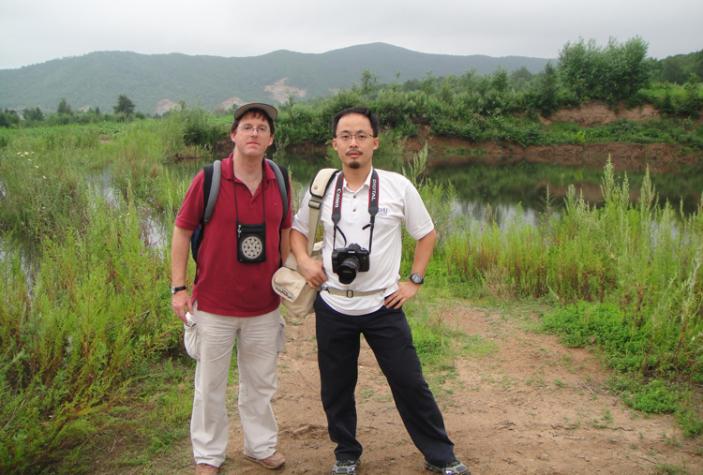
China's two-tier land tenure system is one of the key factors behind China’s recent rise as an Asian powerhouse, say Associate Professors John Donaldson and Forrest Zhang of the SMU School of Social Sciences.

Photo Credit: Professor John Donaldson/SMU
By Prime Sarmiento
SMU Office of Research (19 Nov 2013) – China’s current household-based land rights system, though flawed, will continue to promote food security, protect the welfare of 300 million small farmers and develop the agriculture sector, say Associate Professors John Donaldson and Forrest Zhang of the Singapore Management University (SMU) School of Social Sciences.
They concur with the Chinese government’s decision to retain its two-tier land tenure system of collective ownership coupled with household use, which they say is one of the key factors behind China’s recent rise as an Asian powerhouse.
The Household Responsibility System (HRS), widely credited for reducing rural poverty by increasing farmers’ incomes and productivity, was implemented in the early 1980s shortly after the Chinese government dismantled rural communes.
Under China's unique land ownership system, all farmlands are collectively owned by rural villages and a farmer can only avail of the right to rent the land by virtue of his membership in the village. Individual farming households receive land use rights to cultivate small plots of land and make their own planting decisions, but they do not legally own it.
Calls for rural land reform in China
However, critics argue that the current system of land renting instead of ownership is keeping Chinese agriculture backward and hurting farmers’ interests. They also cite that corrupt officials and developers commit illegal land grabbing because the rules on collective land ownership are not transparent and thus subject to abuse.
As part of the Third Plenum discussions earlier this month, several scholars called on the Chinese leadership to dismantle the small holder farming system, advocating instead for privatisation of land ownership. They say that to modernise agriculture, more productive farmers should be allowed to acquire and work on large tracts of land, while other rural workers migrate to cities and contribute to urbanisation. By having more land, a farmer can achieve economies of scale by investing in and adopting resource-efficient agricultural technologies, they say.
But the SMU researchers’ extensive survey of rural households and qualitative data analysis has revealed a different picture. Not only do the data suggest that most farmers consider the HRS to be more egalitarian than private land ownership, but it is also possible for the current land tenure system to support a modern farming sector. Professor Donaldson notes that by privatising land ownership, Chinese rural farmers will practically give up their bargaining power to large-scale landowners and agribusinesses.
“We argue that China can modernise its small-scale farms by retaining its collective land ownership system,” Professor Donaldson says, adding that productivity is not a matter of having more land, but also the right farming system. Small-scale farmers in China are productive because they have access to technology and subsidies from the government, he says. He acknowledges that land grabbing does exist, but it occurs because of an abuse of power and not because of collective land ownership. And contrary to what critics may say, Professor Donaldson says collective land ownership in fact encourages farmers to band together and fight against land grabbing.
Professor Donaldson notes that the HRS ensures that the farmers have an economically inalienable right to the land that they farm on. Farmers may not be able to sell their land to anyone willing to buy, but they retain their land rights even if they acquire huge debts. This system has put most Chinese farmers in a better position compared to other farmers in developing economies who may be free to own and sell land but are also weighed down by landlessness and poverty.
In India, for instance, poor indebted peasants are forced to sell their land, losing their only source of livelihood. In China, land usage rights give farmers the political power to negotiate with agribusinesses and local government officials. It is this power and inalienable right that has allowed small-scale farmers to modernise and commercialise their farms.
Feeding one-fifth of the world’s population
The duo’s research in the provinces of Fujian, Heilongjiang, Henan, Shandong and Yunnan showed how the farmers’ collaboration with agribusiness companies has transformed their small-scale farms into vertically integrated and large-scale farms that cater to both domestic and export markets.
Shouguang County in Shandong province, for instance, is known for being the biggest vegetable producer in China and home to a large vegetable trading market. Chenggong County in Yunnan province is now a key exporter of cut flowers in Asia and the United States and serves as a base for Asia’s largest flower trading and auction market.
The HRS has also facilitated the establishment of a rental market – another medium for farmers to expand scale of production and commercialise their land. Farmers use the rental markets to transfer land use rights to other farmers to create larger plantations suitable for commercial growing. In the coastal province of Zhejiang, for example, rural households have transferred as much as 60 percent of farmland to others, according to research by Professor Forrest Zhang.
The land usage rights, combined with technological advancements in agriculture and state support, has made China one of the world’s biggest producers of grains, tea, cotton, oilseeds and meat. This is why China, which accounts for only 10 percent of the world’s arable land, has managed to feed 20 percent of the world's population.
Such food security is crucial given China’s political and military ambitions, says Professor Donaldson. “Agriculture is very important to China given its goal of self-sufficiency in food. It can’t be dependent on other countries owing to political and strategic reasons,” he says, adding that the agriculture sector’s contribution to China’s eight trillion dollar economy has been underestimated.
The agriculture sector accounts for roughly 15 percent of Chinese gross domestic product (GDP), a figure dwarfed by manufacturing and services sectors, but “a large part of Chinese society depends on agriculture,” says Professor Donaldson, and the farming sector’s contribution to the economy goes beyond these numbers. Farm productivity has allowed policy makers to use its foreign reserves for industrialisation and encouraged rural labourers to join the manufacturing and service sectors, thus creating a huge labour force.
China’s system of land tenure and other aspects of agriculture modernisation will be explored further in Professor Donaldson and Zhang’s latest research project. The duo were recently awarded a grant by the Singapore Ministry of Education to conduct a three-year study on the transformation of rural China, allowing them to expand their research team and the scope of their research. The researchers will carry out extensive field work in rural provinces and investigate new developments in agriculture, property reform and social welfare programmes.
See More News
Want to see more of SMU Research?
Sign up for Research@SMU e-newslettter to know more about our research and research-related events!
If you would like to remove yourself from all our mailing list, please visit https://eservices.smu.edu.sg/internet/DNC/Default.aspx

